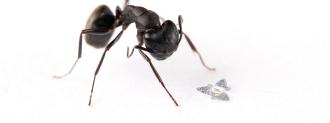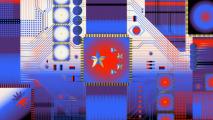Inspired by nature, the latest microchip can dissolve and fly.
About the size of a grain of sand, the chips might be the smallest artificial flying structures yet built — gadgets that could one-day monitor air pollution and the spread of airborne diseases.
Why it matters: Size matters and sometimes smaller is better. With the microfliers, their small size is advantageous as it allows them to float like pollen or seeds, collecting environmental data on their tiny microchips along the way. Wireless transmitters can send the data to scientists before the chips land.
The tiny machines could be released in swarms, scattered across vast landscapes to collect data during flight. But trying to clean up the mess from launching the mini-bots would be like trying to clean up a glitter bomb. So, John Rogers, who led the work, which is published in Nature, designed the microfliers to dissolve in water.
How they work: The small chips don’t have a motor. The researchers from Northwestern University took their inspiration from the maple tree seed to make them fly, which spins like a helicopter propeller as it drops through the air.
“We were able to do that using ideas inspired by the biological world. Over the course of billions of years, nature has designed seeds with very sophisticated aerodynamics. We borrowed those design concepts, adapted them and applied them to electronic circuit platforms,” said Rogers in a statement.
The researchers call the largest devices “mesofliers” or “macrofliers,” which are still smaller than a fruit fly at only two millimeters long. They also made “microfliers,” which are even smaller. Surprisingly, at that size, the machines are equipped with sensors, power supplies, wireless communication antennae, and memory data.
A micro-trend: Miniature devices are becoming increasingly important. As the technology improves, researchers find more nooks and crannies to send in small machines on big missions.
In biomedical research, scientists are building nanomachines that can deliver medicine directly to cells with precision. Resilient bug-sized machines can run as fast as a cheetah and new robot bees can be sent on search and rescue missions.
Understanding nature can play an essential role in advancing small technologies. Researchers looked to lightning bugs to help them understand swarm robotics or built machines that can soar alongside a pesky fly.
“Device miniaturization represents the dominating development trajectory in the electronics industry, where sensors, radios, batteries and other components can be constructed in ever smaller dimensions,” Rogers told SciTechDaily.
Rogers imagines a future where many devices are dropped from great heights after a chemical spill, for example, and the wind spreads across large areas. As they float to the earth, they could track environmental remediation operations or measure pollution throughout the air.
“Most monitoring technologies involve bulk instrumentation designed to collect data locally at a small number of locations across a spatial area of interest,” he said. “We envision a large multiplicity of miniaturized sensors that can be distributed at a high spatial density over large areas, to form a wireless network.”
We’d love to hear from you! If you have a comment about this article or if you have a tip for a future Freethink story, please email us at [email protected].





